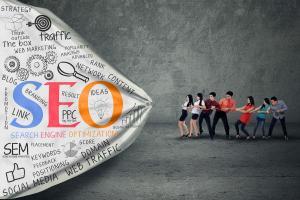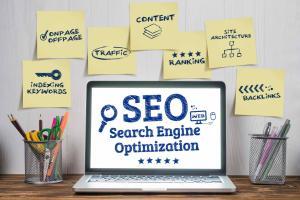In today’s fast-paced digital world, where attention spans are shrinking by the second, a slow-loading website can quickly turn potential customers away from your business. Studies show that users expect websites to load in just a few seconds, and if your site takes longer, they will likely abandon it and move on to a competitor’s site. This is where fast web design becomes crucial for your business.
Fast web design optimizes your website’s load time, ensuring that pages load quickly and seamlessly. You can reduce bounce rates, improve user experience, and increase conversions by implementing fast web design techniques. A fast-loading website keeps visitors engaged and improves your search engine rankings. Search engines like Google consider load time as one of the ranking factors, meaning that a slow website may be pushed down in search results, resulting in lower visibility and potential traffic loss.
The importance of website load time
Fast web design development can give your business a competitive edge in a world where every second counts. By optimizing your website’s load time, you can provide a better user experience, increase conversions, and boost your search engine rankings. Don’t let a slow website hold your business back – invest in fast web design and reap the benefits.
The impact of slow website load time on user experience
Website load time is more than just a number; it is a critical factor that can make or break your online success. In today’s fast-paced society, users have become accustomed to instant gratification. They expect websites to load quickly; they won’t hesitate to leave if they don’t. If your website takes too long to load, you could lose potential customers before they even have a chance to see what you offer.
Slow website load time not only frustrates users but also has a significant impact on their overall experience. Research shows that users are more likely to abandon a website if it takes more than a few seconds to load. This high bounce rate can have negative consequences for your business, as it indicates that visitors are not finding what they are looking for and are not willing to wait around for it.
Moreover, slow website load time can also affect your website’s credibility. Users perceive a slow-loading website as unprofessional and may question the legitimacy of your business. This lack of trust can drive potential customers away, undermining your efforts to establish a solid online presence.
To ensure a positive user experience, it is crucial to prioritize website load time. By investing in fast web design, you can create a seamless browsing experience that will attract users and encourage them to stay and explore what your business offers.
When it comes to website load time, every second counts. Research shows that users have increasingly high expectations regarding website performance, and a delay of just a few seconds can significantly impact their overall experience.
A slow-loading website frustrates users and leads to higher bounce rates. Bounce rate refers to the percentage of visitors who leave your website after viewing only one page. When users encounter a slow-loading website, they are likelier to abandon it and look for alternatives. This high bounce rate can signal to search engines that your website is not meeting user expectations, potentially leading to a drop in search engine rankings.
In addition to increasing bounce rates, slow website load time can negatively impact user engagement. Research shows that users are less likely to interact with a website that takes too long to load. They are less likely to click on links, view additional pages, or complete desired actions such as purchasing or filling out a contact form. This lack of engagement can directly impact your business’s bottom line, reducing the chances of conversions and leading to missed opportunities.
Furthermore, slow website load time can also affect user satisfaction and perception of your brand. Users associate a slow-loading website with poor quality and may question the reliability and professionalism of your business. This negative impression can tarnish your brand’s reputation and complicate building trust with potential customers.
How website load time affects search engine rankings
To ensure a positive user experience and maximize user engagement, it is essential to prioritize fast web design. By optimizing your website’s load time, you can create a seamless browsing experience that will attract users, keep them engaged, and increase the chances of conversions.
In addition to impacting user experience, website load time plays a crucial role in search engine rankings. Search engines like Google consider load time as one of the ranking factors, meaning that a slow-loading website may be pushed down in search results, resulting in lower visibility and potential traffic loss.
Search engines strive to provide the best possible user experience by delivering relevant and high-quality search results. To achieve this, they consider various factors when determining the ranking of a website. Load time is one of these factors, as it directly affects user satisfaction and engagement.
When a user performs a search, search engines aim to deliver results that will provide the best user experience. This includes prioritizing websites that load quickly and seamlessly. A slow website frustrates users and leads to higher bounce rates, indicating that visitors are not finding what they are looking for. Search engines interpret this high bounce rate as a signal that the website is not meeting user expectations and may not be relevant or valuable.
To ensure that your website ranks well in search engine results, it is crucial to prioritize fast web design. By optimizing your website’s load time, you can improve user experience, reduce bounce rates, and increase the chances of ranking higher in search results. This increased visibility can lead to more organic traffic and potential customers discovering your business.
Investing in fast web design can yield numerous benefits for your business. From enhanced user experience to increased conversions, fast web design can give your business a competitive edge in the online marketplace.
Key benefits of fast web design for your business
1. Higher User Engagement and Longer Page Visits
A fast-loading website not only attracts users but also keeps them engaged. Users encountering a website that loads quickly are likelier to explore and interact with its content. This increased engagement can lead to longer page visits, as users are more willing to spend time on a website that provides a seamless browsing experience.
2. Reduced Bounce Rates and Increased Conversions
Slow website load time often leads to higher bounce rates, as users are likelier to abandon a website that takes too long to load. Investing in fast web design can reduce bounce rates and increase the chances of converting visitors into customers. A fast-loading website improves user satisfaction and encourages users to stay and explore what your business offers.
3. Improved Search Engine Rankings and Visibility
As mentioned earlier, search engines consider load time as one of the ranking factors. By optimizing your website’s load time, you can improve your search engine rankings and increase your visibility in search results. This increased visibility can lead to more organic traffic and potential customers discovering your business.
4. Enhanced Mobile User Experience
With the increasing use of mobile devices for internet browsing, it is essential to prioritize fast web design for mobile users. Slow website load time can be even more detrimental on mobile devices, as users are often on the go and have less patience for slow-loading websites. By implementing fast web design techniques, you can provide a seamless browsing experience for mobile users, leading to improved engagement and conversions.
5. Competitive Edge and Brand Reputation
A fast-loading website can give your business a competitive edge in today’s competitive online marketplace. Users have high expectations regarding website performance, and a slow-loading website can quickly turn them away. By investing in fast web design, you can differentiate your business from competitors and establish a reputation for providing a seamless browsing experience.
Improving website load time through optimization techniques
Optimizing your website’s load time requires a combination of technical and design strategies. Implementing the following optimization techniques can improve your website’s load time and provide a better user experience.
- Optimize Image Sizes: Large image files can significantly slow down your website. Compress and resize images to reduce file sizes without compromising quality.
- Minify CSS and JavaScript: Minifying CSS and JavaScript files removes unnecessary characters and whitespace, reducing file sizes and improving load time.
- Enable Browser Caching: Browser caching allows users to store static files, such as images and scripts, locally, reducing the need to download them each time they visit your website.
- Use Content Delivery Networks (CDNs): CDNs distribute your website’s content across multiple servers worldwide, reducing the physical distance between users and your website and improving load time.
- Reduce HTTP Requests: Each file a user’s browser requests add to the load time. Minimize the number of HTTP requests by combining files and using CSS sprites.
- Optimize Code and Database: Clean up your website’s code and database to eliminate redundant or unused elements that can slow download time.
- Choose a Fast-Hosting Provider: Your hosting provider can significantly impact on your website’s load time. Opt for a hosting provider that offers fast servers and reliable performance.
These optimization techniques can significantly improve your website’s load time and provide a better user experience.
Choosing the right hosting provider for faster website performance
When it comes to fast web design, choosing the right hosting provider is crucial. The hosting provider you choose can significantly impact your website’s load time and overall performance. Consider the following factors when selecting a hosting provider:
- Server Speed: Ensure the hosting provider offers fast servers and reliable performance. Look for hosting providers that use SSDs (Solid-State Drives) instead of traditional hard drives, as they provide faster data access.
- Uptime Guarantee: Choose a hosting provider with a high uptime guarantee, ideally 99.9% or higher. A reliable hosting provider ensures that your website is always accessible to users.
- Scalability: Consider the scalability options provided by the hosting provider. As your business grows, you may need to accommodate increased traffic and demand. Ensure the hosting provider can quickly scale your website’s resources to meet your needs.
- Support: Check the hosting provider’s support options and responsiveness. It is crucial to have access to reliable support in case of any technical issues or emergencies.
- Security Measures: Look for hosting providers that offer robust security measures to protect your website and user data. Features such as SSL certificates and regular backups are essential for maintaining the security of your website.
By carefully evaluating these factors and choosing a hosting provider that aligns with your business’s needs, you can ensure faster website performance and a better user experience.
The role of responsive web design in improving load time
Responsive web design is crucial in improving website load time, especially for mobile users. With the increasing use of mobile devices for internet browsing, providing a seamless browsing experience across different screen sizes is essential.
Responsive web design allows your website to adapt and respond to different devices and screen sizes, ensuring users have a consistent experience regardless of their device. By implementing responsive web design, you can eliminate the need to create separate mobile versions of your website, reducing load time and improving user experience.
Responsive web design achieves faster load time by optimizing content display based on the user’s device. It prioritizes essential content and adjusts images and media to fit the screen size, reducing the need to download large files that are unnecessary for the user’s device.
By implementing responsive web design, you can improve your website’s load time and provide a better user experience across all devices, leading to increased engagement and conversions.
Tools and resources for measuring and optimizing website load time.
Measuring and optimizing your website’s load time requires various tools and resources. These tools can provide insights into your website’s performance and help identify areas for improvement. Consider using the following tools:
- Google PageSpeed Insights: This tool analyzes your website’s load time and provides suggestions for improvement. It also provides a score for mobile and desktop performance.
- Pingdom Tools: Pingdom Tools allows you to test your website’s load time from different locations worldwide. It provides detailed reports and performance insights.
- GTmetrix: GTmetrix analyzes your website’s load time and provides a comprehensive report with recommendations for improvement. It also offers video playback of the page load process.
- WebPageTest: WebPageTest allows you to test your website’s load time from different locations and browsers. It provides detailed reports and performance metrics.
- Lighthouse: Lighthouse is an open-source tool developed by Google. It audits your website’s performance, accessibility, best practices, and SEO, providing actionable recommendations for improvement.
Using these tools, you can measure your website’s load time, identify areas for improvement, and optimize your website for better performance.
Case studies of businesses that benefited from fast web design
Numerous businesses have experienced significant benefits from implementing fast web design techniques. Let’s look at a few case studies:
Case Study 1: E-commerce Website
An e-commerce website experienced high bounce rates and low conversion rates due to slow website load time. By optimizing their website’s load time, they reduced bounce rates by 30% and increased conversions by 20%. The faster load time improves user experience, increasing engagement and sales.
Case Study 2: Service-Based Business
A service-based business noticed a drop in search engine rankings and organic traffic due to slow website load time. By investing in fast web design, they were able to improve their website’s load time and increase their search engine rankings. This resulted in a 40% increase in organic traffic and a significant boost in leads and inquiries.
Case Study 3: Blogging Website
A blogging website struggled with high bounce rates and low user engagement. By optimizing their website’s load time, they reduced bounce rates by 25% and increased user engagement. This led to increased page views, longer time on site, and improved brand reputation.
Conclusion: Investing in fast web design for long-term business success
These case studies demonstrate the tangible benefits of fast web design for businesses. Businesses can improve user experience, increase conversions, and achieve long-term success by prioritizing website load time.
Increase your reach and generate even more leads with website speed improvements. Quick Web Designs – the experts in professional website design and optimization. Contact us now for the best service today!







